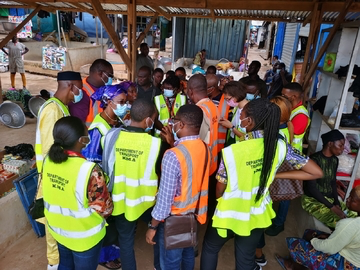Will government tax collectors be able to use the revenue collection software?
Local authority: Kumasi Metropolitan Assembly
Country: Ghana
Kumasi Metropolitan Assembly (KMA) is looking to revolutionise the way it handles local taxes, which is collected manually, done on paper, and paid for in cash. Tax collection across the administrative sub-metros in Kumasi is fragmented, with tax data stored in different offices. For KMA, these factors have clearly resulted in revenue leakages and the reduced ability of the local authority to monitor and budget effectively.
To solve these issues, the focus of KMA’s Local Action Plan is to build a fully digital, centralised system for tax collection in Kumasi, including digitally-based revenue collection and automated updates as part of a centralised system. Kumasi has chosen the open-source dLRev software to do this. dLRev is a tailor-made software solution for Ghana’s Metropolitan, Municipal and District Assemblies, released in 2013 by the German development agency (GIZ) as part of the Support for Decentralisation Reforms (SfDR) programme in Ghana.
The focus of experimentation was to update property and business related data in one sub-metropolitan area, to then trial the use of the dLRev software to print bills and collect taxes for property rates and business operating permits in the pilot location. Collected tax data would then be linked to a newly-created central data server, to enable the real-time reporting and centralised monitoring of the new collection processes.
ASSUMPTION: We believe that available data will enable supervisors to allocate and distribute revenue collectors into various locations to collect and report appropriate revenue collected from each source in the Nhyiaeso sub-metro.
How the Local Action Group tested it
• Chose Nhyiaeso as the pilot sub-metro and subdivided it into fifteen smaller zones to ensure effective supervision.
• Trained and sent out 60 people to collect business and property data using the dLRev software to create a more accurate baseline.
• Trained and sent out 24 revenue collectors to use the dLRev software to distribute demand notices, for both business operating permits and property rate taxes.
What they learned
While the size of the tax database grew, the accuracy of this data can be called into question. KMA was surprised by the increase in the amount of property and business data coming from Nhyiaeso (with increases of 63% and 122%, respectively). However, the team identified some real issues with the accuracy of data collection that needed to be manually rectified. Some issues, such as the classification of certain businesses, fell down to human error from the data collector.
There were clear challenges related to the practicalities of using the new revenue software. Internet connectivity was spotty and unstable and, in using the dLRev application, agents found accessing maps and recording data was slow. Furthermore, whereas some tablets were provided by the local authority, the majority of data collectors were using their own smartphones, where battery life would run low. Finally, mobile data paid for by KMA was often used for private consumption by the agents.
Using the dLRev software removed the collectors’ ability to leak revenue. When it came to bill issuance, some agents were less cooperative with the software, seemingly because there was less ability in the system for money to be appropriated by the agents. Some agents appeared to try and get around this by reverting back to using hand-printed bills.
There was little willingness by citizens to cooperate with data collection. This was particularly true for businesses and business owners. Accessing the right people was also challenging, as the relationship between where a business was previously registered and where it was based was not always the same. Night-time businesses were also seen as much more difficult to report on and some collectors didn’t feel safe in particular areas of the sub-metro. Finally, there was an “affiliation problem” identified, where some citizens felt like they didn’t need to pay a tax because of personal connections.

KMA employees collecting data from a business
Was the assumption validated?
Unclear The team learned that:
• There are many practical challenges to data collection and bill issuance that question whether in the long-term, sustainable gains will be made using this approach.
• One of the initial goals of experimentation was for the Nhyiaeso tax data to be linked to a new, central data server. However, there were issues with procurement that meant this wasn’t completed in time. Without the central data server running, it was not possible to explore the potential of the centralised tax management system.
What next?
KMA wants to continue to use the method in other sub-metros, using the learnings made in this experimentation. They want to:
• Improve the training provided to agents using the dLRev software, including by adjusting the current incentives for collecting tax that reward speed over accuracy.
• Concentrate on citizen sensitisation around data collection, particularly to convey the role of local tax collection in helping to provide municipal services.

E-tax thematic group meeting in Kumasi, July 2021


